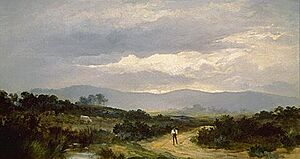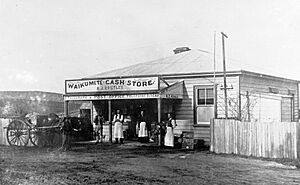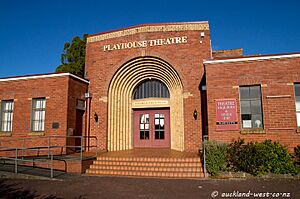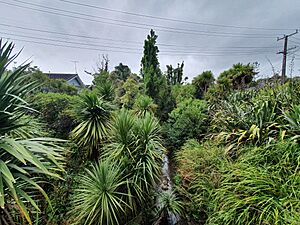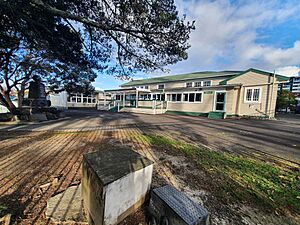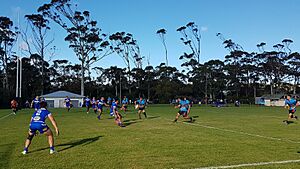Glen Eden, New Zealand facts for kids
Quick facts for kids
Glen Eden
|
|
|---|---|
|
Suburb
|
|

Glen Eden town centre, Playhouse Theatre and Glen Eden library seen from Harold Moody Park
|
|
| Country | New Zealand |
| Local authority | Auckland |
| Electoral ward | Waitākere ward |
| Local board | Waitākere Ranges Local Board |
| Area | |
| • Land | 753 ha (1,861 acre) |
| Population
(June 2023)
|
|
| • Total | Expression error: Unrecognized punctuation character "[". |
| Train station(s) | Glen Eden railway station |
|
|
||
Glen Eden is a busy suburb in West Auckland, New Zealand. It sits at the base of the Waitākere Ranges. This area was first called Waikumete, but its name changed to Glen Eden in 1921. It is part of the Waitākere Ward, which is one of Auckland's main administrative areas. The Auckland Council governs this region.
Long ago, this land belonged to the iwi (tribe) called Te Kawerau ā Maki. Later, during the Colonial era, people started growing fruit in orchards here. The Glen Eden railway station opened in 1880. This connected the area to central Auckland by train. This also led to the creation of the Waikumete Cemetery. Many houses were built in Glen Eden during the 1950s and 1960s.
Contents
Exploring Glen Eden's Landscape
Glen Eden is found at the bottom of the Waitākere Ranges, just north of Titirangi. The Waikumete Stream flows through the middle of the suburb. It creates a valley as it moves north from Titirangi.
This area is part of a special ecological zone. It is protected from the Tasman Sea by the Waitākere Ranges. In the past, tall forests of kauri, tānekaha, and rimu trees grew here. You could also find many nīkau palms and silver ferns. The ground here is a mix of volcanic soil and sedimentary rock.
A Journey Through Glen Eden's History
The land of Glen Eden is part of the traditional rohe (homeland) of Te Kawerau ā Maki. This iwi (tribe) has ancestors who were among the first people in the Auckland Region. West Auckland was known as Hikurangi. The area around Te Wai-o-Pareira / Henderson Creek was called Ōkaurirahi. This name referred to the large kauri forests there.
The northern parts of Glen Eden and Kelston were known as Onewherowhero. This name described the red clay found in the soil. Te Kawerau ā Maki had a kāinga (village) near modern Holdens Road in Oratia. In 1825, many Te Kawerau ā Maki people moved to the Waikato for safety during the Musket Wars. A few stayed behind to keep their connection to the land. They returned in the 1830s, with most settling near a defensive pā (fortified village) at Te Henga / Bethells Beach.
How Glen Eden Got Its Name
After the Treaty of Waitangi was signed in 1840, Apihai Te Kawau, a chief of the Ngāti Whātua Ōrākei iwi, gifted land at Waihorotiu. This land later became the city of Auckland. By this time, the Glen Eden area was known as Waikomiti or Waikumete. This name means "Water of the Wooden Bowl." It referred to a type of trap used to catch kererū (native pigeons). The name Waikūmete originally belonged to Little Muddy Creek in south Titirangi. It was later used for the wider area when Europeans settled. In 1898, the post office officially changed the spelling to Waikumete.
Early European Settlement and Growth
Early settlers like John Bishop and Thomas Canty started clearing the bush in the Oratia and Glen Eden areas in the mid-1840s. Logging kauri trees from the Waitākere Ranges was an early industry. This brought many people to the area. Glen Eden was part of the Titirangi Block, which was sold to the Crown in 1848.
The first permanent European settlers arrived in Glen Eden in 1853. They cleared the land to create orchards. These orchards became very successful in the early 1900s. Many immigrants from Dalmatia (now Croatia) came to live and work here. The clay soil made travel difficult, but it was good for making bricks. An example is Ceramco Park, which was once a brick-making site.
The Arrival of the Railway
The Western Line railway opened in March 1880. This connected Waikumete to Auckland by train and helped the area grow. The train station became the heart of the community. Most businesses opened close to it. In 1886, the Waikumete Cemetery was established nearby. Some people felt the cemetery made the area less appealing to live in.
In 1901, the first town hall was built. In 1910, the first Methodist Church was built in Waikumete. The town hall was a central place for social life. It showed movies, held dances, and hosted political meetings. During World War I, the hall was used to train soldiers.
The Waikumete Cemetery became the burial place for many people who died during the 1918 influenza pandemic. People who passed away in Auckland were brought to Waikumete Cemetery for burial.
Becoming Glen Eden
On November 1, 1921, Waikumete was officially renamed Glen Eden. This happened when the area became a town district. One reason for the name change was that Waikumete was too closely linked to the cemetery. The new name, Glen Eden, referred to Mount Eden in central Auckland. It also highlighted the many valleys (or "glens") in the suburb.
After becoming a town district, Glen Eden grew rapidly as a working-class neighborhood. However, the Great Depression in the 1930s affected the area. Many new houses were empty because people could not afford them.
In 1935, the Glen Eden town hall burned down. It was rebuilt within two years. This new building continued to be a community hub. It hosted events, movies, and theatre shows. Today, it is known as the Glen Eden Playhouse Theatre.
Modern Development
Glen Eden changed from a rural area in the 1940s to a suburb of Auckland in the 1950s. By 1953, the population had grown enough for Glen Eden to become a Borough. This new status brought more money and allowed the local council to develop the area. Between 1951 and 1961, Glen Eden's population tripled. In 1970, Glenmall, a local shopping area, opened near the train station. By the mid-1980s, the population was over 10,000 residents.
Many street names in Glen Eden are named after early residents. Others are named after Antarctic explorers from the Terra Nova Expedition (1910-1913). Most houses are made of wood. You can find old farmhouses, 1930s art deco houses, and post-war bungalows. There are also newer terrace houses.
Glen Eden's Population and Community
Glen Eden covers about 7.53 square kilometers. As of June 2023, it has an estimated population of 20380 people. This means there are about 2707 people per square kilometer.
| Historical population | ||
|---|---|---|
| Year | Pop. | ±% p.a. |
| 2006 | 15,396 | — |
| 2013 | 17,853 | +2.14% |
| 2018 | 19,008 | +1.26% |
| 2023 | 19,593 | +0.61% |
| The 2006 population is for a smaller area of 5.67 km2. | ||
In the 2023 New Zealand census, Glen Eden had 19,593 people. This was an increase of 585 people since the 2018 census. The median age in Glen Eden was 34.6 years. About 22% of the people were under 15 years old.
People in Glen Eden come from many different backgrounds. The census showed that 53.3% were European. Also, 15.6% were Māori, and 21.6% were Pasifika. About 25.1% were Asian. English is spoken by most people (93.6%). Other languages like Māori (3.0%) and Samoan (5.7%) are also spoken. About 35.5% of people were born overseas.
Many people in Glen Eden have religious beliefs. About 33.2% are Christian. Other religions include Hindu (6.7%) and Islam (3.4%). About 44.8% of people said they had no religion.
Places to See and Things to Do
- Ceramco Park: This park was once a clay quarry and landfill. Now, it has the Ceramco Park Function Centre. It is also home to the Glen Eden Athletics and Harrier Club.
- Glen Eden Library: A modern library built in 2004.
- Glen Eden Playhouse Theatre: This building was originally a town hall and cinema. Now, it is a theatre.
- Glen Eden railway station: The local train station, connecting Glen Eden to Auckland.
- Glenmall: Also known as the Glen Eden Village. This is the main shopping area in the suburb. It is located on West Coast Road.
- Hoani Waititi Marae: A special meeting place for Urban Māori from different tribes.
- Parrs Park: A large park in the western part of Glen Eden and Oratia. It is great for recreation.
- Waikumete Cemetery: This is the second largest cemetery in the Southern Hemisphere. It also has 43.9 hectares of protected urban forest and streams. This includes the largest remaining gumland forest in the area.
- Waikumete Stream: A stream that flows through Glen Eden. It starts in Titirangi and flows north. It joins the Oratia Stream at Sunnyvale. The stream is part of Te Ara Hono, a path that links Glen Eden to Kaurilands.
Learning in Glen Eden
In the early 1900s, children went to primary schools in New Lynn and Henderson. In 1915, the first school opened in Glen Eden. It was called Waikumete School, but its name changed to Glen Eden School in 1921. The first school building was moved from New Lynn. Today, Glen Eden Primary School teaches students from years 1 to 6. It has 276 students.
Prospect School opened in 1958. It is also a primary school for years 1 to 6. It has 281 students. Konini School opened in 1976 and is another primary school in the area. Te Kura Kaupapa Māori o Hoani Waititi is a special school that teaches in the Māori language. It has students from years 1 to 13 and has 243 students. All these schools are for both boys and girls.
Glen Eden Intermediate School was built in 1960. It is for students in years 7 and 8. It has 489 students. It is located in the nearby suburb of Kaurilands. For high school, students can go to Kelston Boys' High School or Kelston Girls' College. These schools started as one co-educational high school in 1954, then separated in 1963.
Sports and Fun Activities
The Glenora Rugby League team plays their games at Glenora Park.
Glen Eden is also home to one of New Zealand's oldest Scouts clubs. It has been running since 1925, offering fun activities and learning for young people.
Getting Around Glen Eden
Glen Eden can be reached by West Coast Road. This main road connects to Great North Road at Kelston. It then heads towards Waiatarua in the Waitākere Ranges. Glen Eden also has its own train station, the Glen Eden railway station. It is part of Auckland's Western Line suburban rail network.



